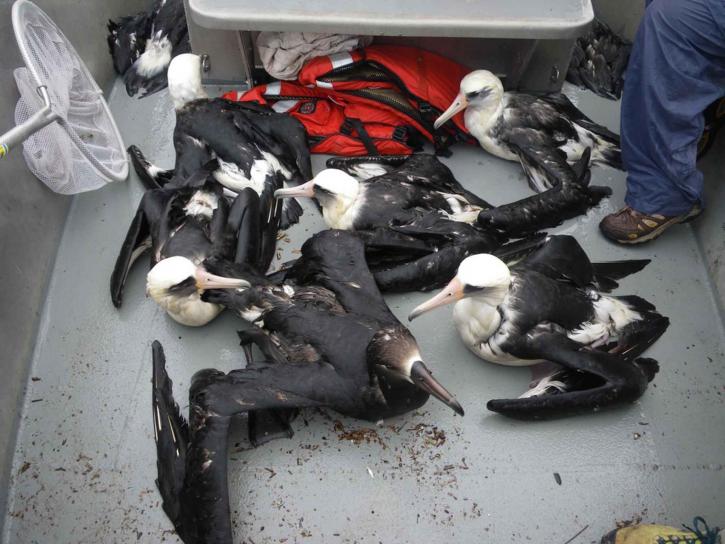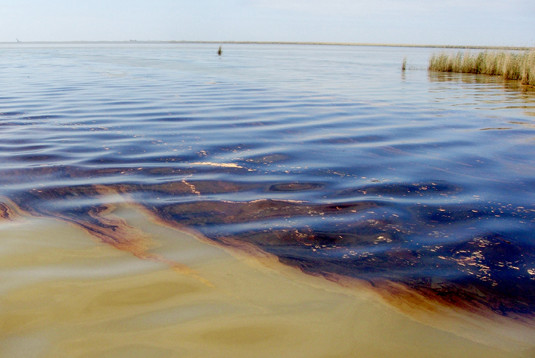It was just a few days before Christmas 1988 when an oil barge accident near the entrance of Grays Harbor unleashed one of the most damaging spills in Northwest history. It was quickly eclipsed by the grounding of the Exxon Valdez just three months later, and today the story of the Nestucca is largely forgotten.
As it turns out, some of the same conditions that led to the Nestucca’s tremendous impact are still with us today. Sightline is studying the accident—and its aftermath—to understand what might happen if the oil industry succeeds in building the three new shipping terminals it has planned for Grays Harbor. In this installment, we tell the story of what happened.
On December 21, 1988, workers at BP’s Cherry Point refinery loaded the tank barge Nestucca with 2.8 million gallons of No. 6 fuel oil. Also known as Bunker C oil and “black tar crude,” No. 6 fuel oil is dark, viscous, and sticky. It literally comes from the bottom of the barrel of refined petroleum, and it resembles tar or asphalt. Plans called for the steel tug Ocean Service to tow the 300-foot Nestucca to Aberdeen (located inside Grays Harbor) to unload some cargo before continuing on to Portland.
Both vessels were operated by Sause Brothers, a BP North America Petroleum contractor based in Coos Bay, Oregon. Sause put five men onboard the Ocean Service tug. Both the captain and chief engineer held maritime licenses from the US Coast Guard, yet federal safety laws required at least half the other crew members hold an “able seaman” certification—none of them met this standard.
Around 11:15 pm on December 22, the ocean swells at Grays Harbor were moderate, and there was little wind. In preparation to cross the bar into the harbor, the crew tightened the towing wire that connected the Nestucca to the Ocean Service. As the captain turned the tug to prepare for entry, the tow wire suddenly snapped. The Nestucca began to drift toward the shore.
A lawsuit later revealed that the tow wire was corroded and worn, and that it had not been properly maintained nor regularly inspected. Sause Brothers mandated inspections when the tow wire was drawn in or let out and that captains document these inspections in a log book. Yet no one had logged an inspection of the tow wire at any time that year. (Captains were supposed to file trip reports as well, but no one had submitted trip reports for the Ocean Service for a full seven months before the oil spill.) The court determined that worn equipment on the Ocean Service contributed to the wire’s failure.
To make matters worse, the Nestucca was not equipped with an “insurance wire,” a spare towing cable that deploys if the main wire is disconnected. Plus, no one except the captain knew how to assemble or deploy the on-board Orville Hook, a “runaway barge” retrieval mechanism.
As the barge drifted toward shallower waters, the captain felt there was no time to deploy the Orville Hook with an untrained crew. Instead, he decided to catch up to the Nestucca so crewmen could jump aboard and throw an emergency tow line back to the tug. This is the most dangerous method to retrieve a barge, a method of last resort.

Oil tanker approaching FPSO by Jon Olav Eikenes used under CC BY 2.0
The captain steered the Ocean Service up to the side of the Nestucca, when a wave caused the two vessels to collide. He tried again, and this time the mate and assistant engineer were able to jump across. Unbeknownst to the crewmen, however, the collision had caused the tug’s rudder to knock a six-foot-by-18-inch gash into one of the Nestucca’s eleven cargo tanks—a hole the size of a large picnic bench. Oil began spilling unnoticed into the dark sea.
Then things went from bad to worse. The collision also damaged the rudder, restricting the Ocean Service’s ability to maneuver. The tug couldn’t get close enough again for the crewmen to attach the emergency tow line or to bring the men back on board. They were stuck on the barge overnight, largely unprotected from the frigid waves and bitter cold.
In the midnight hours of December 23rd, the captain, chief engineer, and cook deployed the Orville Hook and retrieved the barge, preventing the Nestucca from going aground. By now, the wind and waves had picked up. As the sea tossed the barge about, water rushed into the hole, displacing even more oil.
Around 2:00 am, a tug called Janet R arrived to assist. The skipper of the Janet R radioed to Ocean Service, “Oh my God, Chuck, you’re leaking oil!”
Ocean Service notified the Coast Guard, which in turn notified the Washington Department of Ecology. The two agencies decided against towing the barge into Grays Harbor because they did not want the oil to impact the bay’s environment, and they did not know at what rate oil was spilling out of the damaged barge. What’s more, Grays Harbor did not have adequate facilities for dealing with an oil spill. So the agencies instructed the vessels to move out to sea. Officials hoped the oil would drift out and disperse, minimizing environmental impact—a hope that showed lack of knowledge of the properties of Bunker C oil and the currents at that time of year.
“Of the 13,000 oiled birds collected by clean-up volunteers, only 1,000 survived.”
The Janet R helped Ocean Service tow the Nestucca southwest about twenty miles off the mouth of the Columbia River. By 7:00 a.m. on December 23, the waters had calmed enough for the Janet R to retrieve the crewmen from the Nestucca. At 9:00 a.m., the Coast Guard delivered a barge patching kit to the Janet R, but the weather prevented the crew from performing any work. That morning, the first oil washed ashore near Ocean Shores, Washington. By 4:00 p.m., an oil slick about 300 feet wide and 2 to 3 miles long was observed inside Grays Harbor near Little Goose and Sand Islands. It was not until after midnight that the crew was able to start work on the barge. They completed a temporary patch around 1:00 a.m. on Christmas Eve—more than 24 hours after the spill began.
Sause Brothers then towed the Nestucca to Astoria, Oregon. An on-scene coordinator reported a light sheen trailing behind.
No one made any effort to contain or recover the oil, in part because no one knew at first how much oil had been spilled. Once workers had patched the Nestucca on Dec. 24th, officials estimated the spill at 70,000 gallons. A full week passed before BP provided a revised estimate showing that 231,000 gallons had spilled from the 252,000-gallon tank. There was enough oil in the water to fill 20 large tanker trucks. It was one of the worst oil spills ever to hit Washington waters.
For a few days, news outlets reported the spill as a small incident that was quickly being remediated. Alarm set in as subsurface oil patties traveled north, invisible to helicopters surveying the spill, oiling 110 miles of Washington’s shoreline. On New Year’s Eve, a Canadian lighthouse keeper observed oil from the Nestucca on the southwest coast of Vancouver Island. Oil continued to spread north, washing ashore sporadically along all 310 miles of the western coast of Vancouver Island until early February 1989.
Although the spill was smaller than other oil spills in terms of quantity, its impact was disproportionate due to the type of oil spilled. Bunker C oil maintains a slick on water longer than other fuels, and it dissipates slowly, so it can migrate over long distances. The winter current, winds, and storms dispersed the oil over 800 square miles. It washed ashore as far north as the Scott Islands (north of Vancouver Island) and as far south as Newport, Oregon. It fouled the lands of the Nuu-Chah-Nulth nations of Canada and the Quinault Nation of Washington. Canadian officials closed fisheries and commercial harvesting locations for up to six months.
The oil affected highly sensitive ecological areas, including Olympic National Park, five national wildlife refuges in Washington, and Pacific Rim National Park in British Columbia. Many rocky or difficult-to-reach shores were “left to cleanse themselves,” according to the Washington State Department of Ecology, even though Bunker C oil takes at least five to ten years to degrade in the environment.

Albatross Oil Spill by Public Domain
We’ll never know how many birds were killed by the Nestucca spill, but we do know that of the 13,000 oiled birds collected by clean-up volunteers, only 1,000 survived. Only a fraction of deceased birds are recovered after an oil spill, and the US Fish and Wildlife Service estimates that actual bird mortality was 52,000 to 78,000. Many oiled birds die at sea and sink, die in secluded land locations, or are eaten by predators.
The spill also had a major impact on international relations. By mid-January of 1989, many Canadians believed their shores had been sacrificed in an effort to save Grays Harbor. A fisherman’s union representative called the decision to move Nestucca out to sea a “scandal” that showed “complete disregard for the environment and for Canadians.” British Columbia’s Environment Minister suggested that Sause Brothers pick up the 278 tons of oil-soaked sand and debris collected in Canada and bring it back to the United States. Canadian citizens organized protests, put oiled beach gunk on public display, and a few sent death threats to the Canadian Coast Guard, which handled cleanup in British Columbia. A minority party in BC asked the International Joint Commission, an intergovernmental agency that mediates disputes, to initiate an inquiry into the handling of the spill.
In late January 1989, Washington Governor Booth Gardner and BC Premier Bill Vander Zalm signed a “memorandum of cooperation,” seeking to enable quicker action on oil spills that threatened the states’ shared environment and to “settle questions of jurisdiction and cost later.”
There was just one small problem with the cleanup agreement: it was almost exactly the same as an agreement signed in 1972 after the Cherry Point spill in Whatcom County. Vander Zalm’s special oil spill advisor called the first agreement “window dressing,” and environmentalists called the second agreement a “sham.”
“Are the lessons we learned forgotten until the next oil spill?”
The 1989 agreement may well have remained a sham but for its timing: the Oil Spill Task Force held its first meeting the day before the Exxon Valdez oil spill. Soon after, Alaska, Oregon, and California joined the task force and, at the time, all participants except BC acknowledged that they probably lacked the funding to meet or seriously pursue the goals of the agreement. Motivated by the public response to the Exxon Valdez, lawmakers incorporated recommendations made by the task force into state and federal legislation such as the Oil Pollution Act of 1990, plugging some of the gaps in regulatory oversight of oil transportation.
Are the lessons we learned forgotten until the next oil spill? To answer this question, Sightline is investigating the outcomes of the Nestucca. The next article on the spill will address the decades-long Nestucca remediation process, what oil companies got away with in settlements, and the efficacy of regulatory changes set in motion by the Nestucca disaster.
In addition to the sources linked in this article, we used the following print-only sources:
- Britton, Douglas F. “The Privitization of the American Fishery: Limitations, Recognitions and the Public Trust.” Oregon and Coastal Law Journal 3 Ocean & Coastal L. J. 217 (1997): 217-257.
- Davis, J. C. Department of Fisheries and Oceans. “Nestucca” Oil Spill Report on Spill Response. June 1989.
- Deschamps, Isabelle, et al. “What crises could teach us about complexity and systemic management: The case of the Nestucca oil spill.” Technological Forecasting and Social Change 55 (1997): 107-129.
- Gregoire, Christine, and Lewey Kittle. Washington State Department of Ecology. Nestucca Oil Spill On-Scene Coordinator’s Report. August 1989.
- Pacific States/British Columbia Task Force on Oil Spills. Final Report of the Pacific States/British Columbia Oil Spill Task Force. 1990.
- Waldichuk, M. “The Nestucca Oil Spill.” Marine Pollution Bulletin (1989): 419-420.
- Washington Department of Ecology. Summary of Events and News Coverage 1988/1989 Grays Harbor Oil Spill. 1989.











Terrah Hatch
I was one of the volunteers out on the beaches picking up birds. I spent my entire winter break from school out there picking up birds. I’m shocked to know now that hardly any survived. Makes me so sad and angry!
Waltciv
I was with the Washington conservation Corp. We were on beach clean-up. We were out on those breaches for two months. Back and forth from cabins to beach by helicopters. An incredible time. I was in my early 20s.
Phil B.
I was a freshman at the UW at the time. I vaguely remember this spill, but certainly remember the protest rally in Seattle against Exxon after the Valdez. The first environmental event I had ever attended.
Scott Chace
I sailed as mate for Sause Brothers back at the time of this accident It was a real cowboy operation. Inexperienced captains, poor equipment, and a company policy that pushed profit over safety.
My first time docking a barge was when the captain was too drunk to show up for the task.
Jan H
I was one of the volunteers at the Ocean Shores Convention Center. Because the birds couldn’t eat normally, they were tube fed. It was so stressful for the birds in addition to the cleanings they were getting. It was so sad! I was one of the tube feeders. I held a bird in my lap, opened it’s mouth and stuck my left thumb in it’s beak to keep it open, then I used my right hand to thread a tube down it’s throat to pump in the slurry of food that was mixed for them. The whole process was very hard on them.